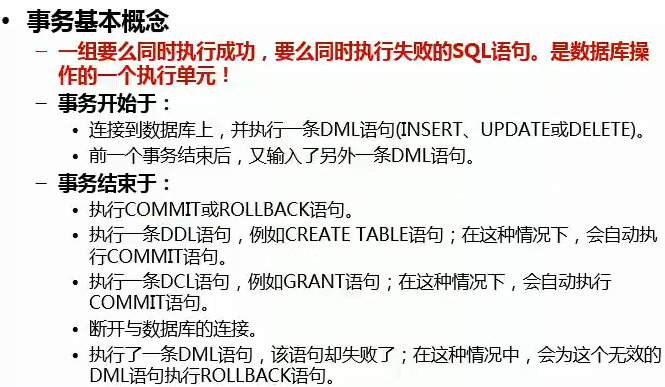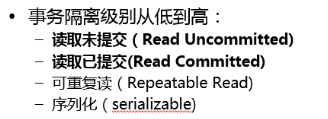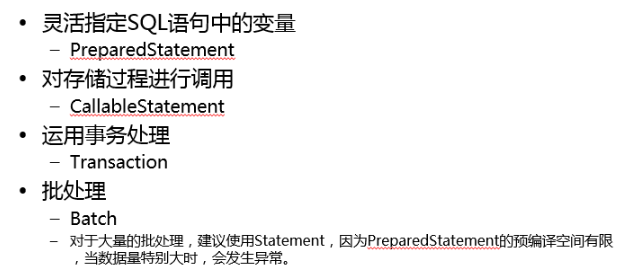【数据库】jdbc详解
try {
if(resultSet!=null){
resultSet.close();
}
}catch (SQLException e){
e.printStackTrace();
}finally {
try {
if(preparedStatement!=null){
preparedStatement.close();
}
}catch (Exception e){
e.printStackTrace();
}
try {
if(connection!=null){
connection.close();
}
}catch (Exception e){
e.printStackTrace();
}
}
转载:https://www.cnblogs.com/erbing/p/5805727.html
一、相关概念
1.什么是JDBC
JDBC(Java Data Base Connectivity,java数据库连接)是一种用于执行SQL语句的Java API,可以为多种关系数据库提供统一访问,它由一组用Java语言编写的类和接口组成。JDBC提供了一种基准,据此可以构建更高级的工具和接口,使数据库开发人员能够编写数据库应用程序。
2.数据库驱动
我们安装好数据库之后,我们的应用程序也是不能直接使用数据库的,必须要通过相应的数据库驱动程序,通过驱动程序去和数据库打交道。其实也就是数据库厂商的JDBC接口实现,即对Connection等接口的实现类的jar文件。

二、常用接口
1.Driver接口
Driver接口由数据库厂家提供,作为java开发人员,只需要使用Driver接口就可以了。在编程中要连接数据库,必须先装载特定厂商的数据库驱动程序,不同的数据库有不同的装载方法。如:
装载MySql驱动:Class.forName("com.mysql.jdbc.Driver");
装载Oracle驱动:Class.forName("oracle.jdbc.driver.OracleDriver");
2.Connection接口
Connection与特定数据库的连接(会话),在连接上下文中执行sql语句并返回结果。DriverManager.getConnection(url, user, password)方法建立在JDBC URL中定义的数据库Connection连接上。
连接MySql数据库:Connection conn = DriverManager.getConnection("jdbc:mysql://host:port/database", "user", "password");
连接Oracle数据库:Connection conn = DriverManager.getConnection("jdbc:oracle:thin:@host:port:database", "user", "password");
连接SqlServer数据库:Connection conn = DriverManager.getConnection("jdbc:microsoft:sqlserver://host:port; DatabaseName=database", "user", "password");
常用方法:
- createStatement():创建向数据库发送sql的statement对象。
- prepareStatement(sql) :创建向数据库发送预编译sql的PrepareSatement对象。
- prepareCall(sql):创建执行存储过程的callableStatement对象。
- setAutoCommit(boolean autoCommit):设置事务是否自动提交。
- commit() :在链接上提交事务。
- rollback() :在此链接上回滚事务。
3.Statement接口
用于执行静态SQL语句并返回它所生成结果的对象。
三种Statement类:
- Statement:由createStatement创建,用于发送简单的SQL语句(不带参数)。
- PreparedStatement :继承自Statement接口,由preparedStatement创建,用于发送含有一个或多个参数的SQL语句。PreparedStatement对象比Statement对象的效率更高,并且可以防止SQL注入,所以我们一般都使用PreparedStatement。
- CallableStatement:继承自PreparedStatement接口,由方法prepareCall创建,用于调用存储过程。
常用Statement方法:
- execute(String sql):运行语句,返回是否有结果集
- executeQuery(String sql):运行select语句,返回ResultSet结果集。
- executeUpdate(String sql):运行insert/update/delete操作,返回更新的行数。
- addBatch(String sql) :把多条sql语句放到一个批处理中。
- executeBatch():向数据库发送一批sql语句执行。
4.ResultSet接口
ResultSet提供检索不同类型字段的方法,常用的有:
- getString(int index)、getString(String columnName):获得在数据库里是varchar、char等类型的数据对象。
- getFloat(int index)、getFloat(String columnName):获得在数据库里是Float类型的数据对象。
- getDate(int index)、getDate(String columnName):获得在数据库里是Date类型的数据。
- getBoolean(int index)、getBoolean(String columnName):获得在数据库里是Boolean类型的数据。
- getObject(int index)、getObject(String columnName):获取在数据库里任意类型的数据。
ResultSet还提供了对结果集进行滚动的方法:
- next():移动到下一行
- Previous():移动到前一行
- absolute(int row):移动到指定行
- beforeFirst():移动resultSet的最前面。
- afterLast() :移动到resultSet的最后面。
使用后依次关闭对象及连接:ResultSet → Statement → Connection
三、使用JDBC的步骤
加载JDBC驱动程序 → 建立数据库连接Connection → 创建执行SQL的语句Statement → 处理执行结果ResultSet → 释放资源
1.注册驱动 (只做一次)
方式一:Class.forName(“com.MySQL.jdbc.Driver”);
推荐这种方式,不会对具体的驱动类产生依赖。
方式二:DriverManager.registerDriver(com.mysql.jdbc.Driver);
会造成DriverManager中产生两个一样的驱动,并会对具体的驱动类产生依赖。
2.建立连接
Connection conn = DriverManager.getConnection(url, user, password);
URL用于标识数据库的位置,通过URL地址告诉JDBC程序连接哪个数据库,URL的写法为:

其他参数如:useUnicode=true&characterEncoding=utf8
3.创建执行SQL语句的statement
//存在sql注入风险,statement
public static void main(String[] args) throws SQLException {
try {
Class.forName("com.mysql.jdbc.Driver");
} catch (ClassNotFoundException e) {
e.printStackTrace();
}
testDelete();
}
public static void testDelete() throws SQLException{
Connection connection=getConnection();
Statement statement=createStatement(connection);
String id="2";
//存在sql注入的危险
//如果用户传入的id为“5 or 1=1”,那么将删除表中的所有记录
String sql="delete from t_blog where id="+id;
statement.execute(sql);
}
public static Connection getConnection() throws SQLException {
return DriverManager.getConnection(jdbcUrl,user,pwd);
}
public static Statement createStatement(Connection connection) throws SQLException {
return connection.createStatement();
}
//不存在sql诸如风险,PreparedStatement
public static void main(String[] args) throws SQLException {
try {
Class.forName("com.mysql.jdbc.Driver");
} catch (ClassNotFoundException e) {
e.printStackTrace();
}
testPreparedStatement();
}
public static void testPreparedStatement() throws SQLException {
Connection connection = getConnection();
int id = 1;
String sql = "delete from t_blog where id=?";
//PreparedStatement 有效的防止sql注入(SQL语句在程序运行前已经进行了预编译,当运行时动态地把参数传给PreprareStatement时,
//即使参数里有敏感字符如 or '1=1'也数据库会作为一个参数一个字段的属性值来处理而不会作为一个SQL指令)
PreparedStatement preparedStatement = createPreparedStatement(connection, sql);
preparedStatement.setInt(1, id);//占位符顺序从1开始
int clomSize = preparedStatement.executeUpdate();
System.out.println("影响的数据库行数=》" + clomSize);
}
public static PreparedStatement createPreparedStatement(Connection connection, String sql) throws SQLException {
return connection.prepareStatement(sql);
}
public static Connection getConnection() throws SQLException {
return DriverManager.getConnection(jdbcUrl, user, pwd);
}
//处理结果
public static void main(String[] args) throws SQLException {
try {
Class.forName("com.mysql.jdbc.Driver");
} catch (ClassNotFoundException e) {
e.printStackTrace();
}
testResult();
}
public static void testResult() throws SQLException{
Connection connection = getConnection();
int id=2;
String sql="select * from t_blog where id>=?";
PreparedStatement preparedStatement=createPreparedStatement(connection,sql);
preparedStatement.setInt(1,id);
ResultSet resultSet=preparedStatement.executeQuery();
while (resultSet.next()){
int rid=resultSet.getInt(1);
String name=resultSet.getString(2);
String context=resultSet.getString(3);
Date date=resultSet.getDate(4);
System.out.println("读取的记录=>"+rid+"-"+name+"-"+context+"-"+ DateFormatUtils.format(date,"yyyy-MM-dd HH:mm:ss"));
}
}
public static PreparedStatement createPreparedStatement(Connection connection, String sql) throws SQLException {
return connection.prepareStatement(sql);
}
public static Connection getConnection() throws SQLException {
return DriverManager.getConnection(jdbcUrl, user, pwd);
}
//释放资源
try {
if(resultSet!=null){
resultSet.close();
}
}catch (SQLException e){
e.printStackTrace();
}finally {
try {
if(preparedStatement!=null){
preparedStatement.close();
}
}catch (Exception e){
e.printStackTrace();
}
try {
if(connection!=null){
connection.close();
}
}catch (Exception e){
e.printStackTrace();
}
}
四、事务(ACID特点、隔离级别、提交commit、回滚rollback)



1.批处理Batch

public static void main(String[] args) throws SQLException {
try {
Class.forName("com.mysql.jdbc.Driver");
} catch (ClassNotFoundException e) {
e.printStackTrace();
}
testBatch();
}
public static void testBatch() throws SQLException {
Connection connection = getConnection();
Statement statement=connection.createStatement();
for(int i=4;i<104;i++){
String sql="insert into t_blog (id,name,context,createDateTime) values ('"+i+"','tst3数据库','jdbc学习3','2018-01-01 12:00:00') ";
statement.addBatch(sql);
}
statement.executeBatch();
statement.close();
connection.close();
}
【数据库】jdbc详解的更多相关文章
- SAE上传web应用(包括使用数据库)教程详解及问题解惑
转自:http://blog.csdn.net/baiyuliang2013/article/details/24725995 SAE上传web应用(包括使用数据库)教程详解及问题解惑: 最近由于工作 ...
- Spring4 JDBC详解
Spring4 JDBC详解 在之前的Spring4 IOC详解 的文章中,并没有介绍使用外部属性的知识点.现在利用配置c3p0连接池的契机来一起学习.本章内容主要有两个部分:配置c3p0(重点)和 ...
- JDBC详解系列(二)之加载驱动
---[来自我的CSDN博客](http://blog.csdn.net/weixin_37139197/article/details/78838091)--- 在JDBC详解系列(一)之流程中 ...
- JDBC详解系列(三)之建立连接(DriverManager.getConnection)
在JDBC详解系列(一)之流程中,我将数据库的连接分解成了六个步骤. JDBC流程: 第一步:加载Driver类,注册数据库驱动: 第二步:通过DriverManager,使用url,用户名和密码 ...
- JDBC详解(一)
一.相关概念介绍 1.1.数据库驱动 这里驱动的概念和平时听到的那种驱动的概念是一样的,比如平时购买的声卡,网卡直接插到计算机上面是不能用的,必须要安装相应的驱动程序之后才能够使用声卡和网卡,同样道理 ...
- Java基础-面向接口编程-JDBC详解
Java基础-面向接口编程-JDBC详解 作者:尹正杰 版权声明:原创作品,谢绝转载!否则将追究法律责任. 一.JDBC概念和数据库驱动程序 JDBC(Java Data Base Connectiv ...
- JDBC详解1
JDBC详解1 JDBC整体思维导图 JDBC入门 导jar包:驱动! 加载驱动类:Class.forName("类名"); 给出url.username.password,其中u ...
- windows phone 8.1开发SQlite数据库操作详解
原文出自:http://www.bcmeng.com/windows-phone-sqlite1/ 本文小梦将和大家分享WP8.1中SQlite数据库的基本操作:(最后有整个示例的源码)(希望能通过本 ...
- MySQL数据库优化详解(收藏)
MySQL数据库优化详解 mysql表复制 复制表结构+复制表数据mysql> create table t3 like t1;mysql> insert into t3 select * ...
- 如何查看mysql数据库的引擎/MySQL数据库引擎详解
一般情况下,mysql会默认提供多种存储引擎,你可以通过下面的查看: 看你的mysql现在已提供什么存储引擎:mysql> show engines; 看你的mysql当前默认的存储引擎:mys ...
随机推荐
- vue-12-渲染函数 & JSX
render() Vue.component('anchored-heading', { render: function (createElement) { return createElement ...
- 3.1 Makefile
安装make 安装make sudo apt-get install make make -v
- h5视频配置
<!DOCTYPE html PUBLIC "-//W3C//DTD XHTML 1.0 Transitional//EN" "http://www.w3.org/ ...
- form 表单模板
<div class="modal-dialog modal-lg"> //大布局modal-lg <div class="modal-content& ...
- .NET界面控件DevExpress发布v18.2.4|附下载
DevExpress Universal Subscription(又名DevExpress宇宙版或DXperience Universal Suite)是全球使用广泛的.NET用户界面控件套包,De ...
- 从原理上理解如何由震源机制一个节面的解:strike,dip,rake可以求出另一个节面的解
首先,需要回到最原始的地震矩的表达式: 已知strike,dip,rake 根据strike和dip可以求出v,根据strike,dip,rake,可以求出u. 把求出来的v和u互换,相当于原来的位错 ...
- kettle在linux下执行任务
1.下载 最新版下载 7.1 https://community.hitachivantara.com/docs/DOC-1009855 准备 上传任务文件 .kjb,.ktr 上传mysql 驱动 ...
- 实力封装:Unity打包AssetBundle(二)
→前情提要:Unity最基本的AssetBundle打包方式. 第二种打包方式 Unity提供的BuildAssetBundles API还有一个重载形式,看下面↓↓ public static As ...
- suse 12 sp1 系统添加zabbix agent监控
因为之前走入一个误区,认为linux系统的zabbix安装包都是一样的,其实不同的linux的系统对应的版本是不一样的. suse系统版本(不同版本之间也是有区别的):SUSE Linux 12 S ...
- ios轮播图片用法
// // ZQRViewController.m // 04-图片轮播器 // // Created by apple on 17-08-24. // Copyright (c) 2017年 zzq ...
